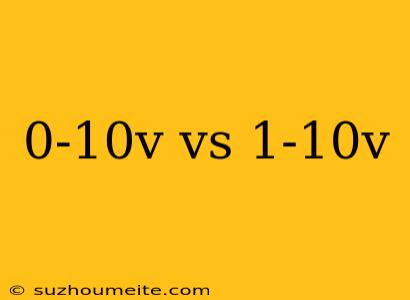0-10V vs 1-10V: Understanding the Difference
When it comes to analog signals in industrial automation, two common voltage ranges are often used: 0-10V and 1-10V. While they may seem similar, these two ranges have distinct differences that are essential to understand to ensure proper system design and operation.
What are 0-10V and 1-10V signals?
0-10V Signals
A 0-10V signal is a type of analog signal that varies between 0 volts and 10 volts. This signal range is commonly used in industrial automation applications, such as process control, measurement, and monitoring. In a 0-10V system, the output voltage is directly proportional to the measured physical parameter, such as temperature, pressure, or flow rate.
1-10V Signals
A 1-10V signal, on the other hand, is a type of analog signal that varies between 1 volt and 10 volts. This signal range is also used in industrial automation, but it is less common than 0-10V signals.
Key Differences
So, what are the key differences between 0-10V and 1-10V signals?
Offset Voltage
The most significant difference is the offset voltage. In a 0-10V system, the output voltage can be zero, indicating a minimum or zero value of the measured parameter. In contrast, a 1-10V system has an offset voltage of 1 volt, which means that even when the measured parameter is at its minimum value, the output voltage is still 1 volt.
Sensitivity and Resolution
0-10V signals typically offer better sensitivity and resolution than 1-10V signals. This is because the full 10-volt range is available for the signal, allowing for more precise measurements. In contrast, the 1-10V range has a reduced range, which can result in lower sensitivity and resolution.
Compatibility and Interoperability
0-10V signals are more widely adopted and compatible with a broader range of devices and systems. Many industrial automation devices, such as PLCs, DCSs, and instruments, are designed to work with 0-10V signals. 1-10V signals, on the other hand, may require additional signal conditioning or conversion to be compatible with these devices.
When to Use Each
0-10V Signals
Use 0-10V signals when:
- High sensitivity and resolution are required
- Zero-based measurements are necessary
- Compatibility with a wide range of devices is essential
1-10V Signals
Use 1-10V signals when:
- A minimum voltage threshold is required (e.g., for safety or noise reduction)
- Limited signal range is acceptable
- Compatibility issues are not a concern
Conclusion
In conclusion, while 0-10V and 1-10V signals may seem similar, they have distinct differences that are critical to understand in industrial automation applications. By choosing the right signal range for your specific application, you can ensure accurate and reliable measurements, improved system performance, and reduced compatibility issues.
